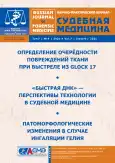Двойная экспоненциальная модель охлаждения трупа в условиях линейно изменяющейся внешней температуры
- Авторы: Недугов Г.В.1
-
Учреждения:
- Самарский государственный медицинский университет
- Выпуск: Том 7, № 4 (2021)
- Страницы: 19-28
- Раздел: Оригинальные исследования
- URL: https://journals.rcsi.science/2411-8729/article/view/122411
- DOI: https://doi.org/10.17816/fm429
- ID: 122411
Цитировать
Полный текст
Аннотация
Обоснование. Основным условием корректного определения давности наступления смерти, одновременно ограничивающим область применения метода термометрии глубоких тканей трупа, является постоянство температуры внешней среды. Приоритет термометрии ядра тела в диагностике давности наступления смерти объясняется более медленным остыванием глубоких тканей, позволяющим увеличить продолжительность посмертного интервала, доступного диагностике, и меньшей подверженностью влиянию различных случайных факторов на процесс охлаждения. Предложенные в последнее время конечно-элементные модели могут учитывать практически все существенные условия охлаждения, в том числе и изменения внешней температуры, однако из-за своей высокой сложности требуют наличия серьёзной физико-математической подготовки и технических навыков, дорогостоящего программного обеспечения и посмертной компьютерной томографии. По этим причинам они не нашли пока широкого применения в экспертной практике.
В настоящей статье предложена математическая модель охлаждения ядра трупа при линейно изменяющейся внешней температуре.
Цель исследования — построить математическую модель охлаждения ядра трупа на основе феноменологического закона Marshall-Hoare в условиях линейно изменяющейся внешней температуры; найти численный алгоритм решения построенной модели и разработать реализующую его компьютерную программу.
Материал и методы. На базе феноменологического закона охлаждения Marshall-Hoare выполнено прямое аналитическое моделирование охлаждения трупа в условиях линейно изменяющейся температуры внешней среды.
Результаты. Разработана математическая модель охлаждения ядра трупа в условиях линейно изменяющейся внешней температуры. В качестве численного алгоритма решения этой модели предложен метод хорд. Разработанная математическая модель и итерационный алгоритм её решения, а также вычисления интервальных оценок посмертного интервала реализованы на языке C# в формате компьютерной программы Warm Bodies MHNH.
Заключение. Предложенную модель и реализующую её программу целесообразно использовать в судебно-медицинской экспертной практике при определении давности наступления смерти по ректальной или краниоэнцефальной температуре трупа в условиях линейно изменяющейся температуры внешней среды.
Полный текст
Открыть статью на сайте журналаОб авторах
Герман Владимирович Недугов
Самарский государственный медицинский университет
Автор, ответственный за переписку.
Email: nedugovh@mail.ru
ORCID iD: 0000-0002-7380-3766
SPIN-код: 3828-8091
Scopus Author ID: 25947646500
ResearcherId: ABH-5590-2020
д.м.н., доцент
Россия, 443099, Самара, ул. Чапаевская, д. 89Список литературы
- Marshall T.K., Hoare F.E. Estimating the time of death. The rectal cooling after death and its mathematical expression // J Forensic Sci. 1962. Vol. 7, N 1. P. 56–81.
- Henssge C. Death time estimation in case work. I. The rectal temperature time of death nomogram // Forensic Sci Int. 1988. Vol. 38, N 3-4. P. 209–236. doi: 10.1016/0379-0738(88)90168-5
- Henssge C. Rectal temperature time of death nomogram: dependence of corrective factors on the body weight under stronger thermic insulation conditions // Forensic Sci Int. 1992. Vol. 54, N 1. P. 51–66. doi: 10.1016/0379-0738(92)90080-g
- Althaus L., Henssge C. Rectal temperature time of death nomogram: sudden change of ambient temperature // Forensic Sci Int. 1999. Vol. 99, N 3. P. 171–178. doi: 10.1016/s0379-0738(98)00188-1
- Bisegna P., Henssge C., Althaus L., Giusti G. Estimation of the time since death: sudden increase of ambient temperature // Forensic Sci Int. 2008. Vol. 176, N 2-3. P. 196–199. doi: 10.1016/j.forsciint.2007.09.007
- Недугов Г.В. Математическое моделирование охлаждения трупа в условиях изменяющейся температуры окружающей среды // Судебная медицина. 2021. Т. 7, N 1. С. 29–35. doi: 10.17816/fm360
- Недугов Г.В. Численный метод решения двойных экспоненциальных моделей охлаждения трупа при установлении давности наступления смерти // Судебно-медицинская экспертиза. 2021. Т. 64, N 6. С. 25–28. doi: 10.17116/sudmed20216406125
- Madea B. Methods for determining time of death // Forensic Sci Med Pathol. 2016. Vol. 12, N 4. P. 451–485. doi: 10.1007/s12024-016-9776-y
- Henssge C., Madea B. Estimation of the time since death in the early post-mortem period // Forensic Sci Int. 2004. Vol. 144, N 2-3. P. 167–175. doi: 10.1016/j.forsciint.2004.04.051
- Недугов Г.В. Новые компьютерные технологии определения давности наступления смерти по методу Henssge // Судебная медицина. 2021. Т. 7, N 3. С. 152–158. doi: 10.17816/fm406
- Mall G., Eisenmenger W. Estimation of time since death by heat-flow Finite-Element model. Part I: method, model, calibration and validation // Leg Med (Tokyo). 2005. Vol. 7, N 1. P. 1–14. doi: 10.1016/j.legalmed.2004.06.006
- Mall G., Eisenmenger W. Estimation of time since death by heat-flow Finite-Element model. Part II: application to non-standard cooling conditions and preliminary results in practical casework // Leg Med (Tokyo). 2005. Vol. 7, N 2. P. 69–80. doi: 10.1016/j.legalmed.2004.06.007
- Schenkl S., Muggenthaler H., Hubig M., et al. Automatic CT-based finite element model generation for temperature-based death time estimation: feasibility study and sensitivity analysis // Int J Legal Med. 2017. Vol. 131, N 3. P. 699–712. doi: 10.1007/s00414-016-1523-0
Дополнительные файлы











